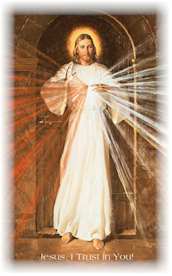|
IN
THIS ISSUE:
Cover
Page
by Bro.
Pete Lapid
The
Father Speaks
By Fr.
Binzler, SJ
Special
Feature
By
Pinky Torres
Our
Faith
By Fr.
KJ Veeger, MSC
Place
of Refuge
By
Philip Yuson
Inspirations
By
Desomnd D'Souza
Genesis
Happenings
By
Sansu Garin
Special
Feature
By Fr.
Jojo San Juan, SDB
Surabaya
Corner
By
Ramon Martillano
Saint
for the Month
|
-
- Catholic
Links
|
|
 - PROFILE
OF THE
- GENESIS
CATHOLIC COMMUNITY
|
|
|
INSPIRATIONS
  -
|
The
message of Christ's mercy is a message for the new
millennium as the Holy Father said “ We do not know what
the years ahead will br ing
us, but the light of Divine Mercy will illumine the way
for the men and women of the third millennium”.
It
was a festive day at the St. Peter’s Square as the whole
nation witnessed the canonization of the first saint for
the Jubilee Year and the Holy Father’s announcement that
the Sunday after Easter would be known as “Divine
Mercy Sunday.”
It
all started in 1905 in a small village in Poland when a girl by the name of Helen Kowalska was born.
At the age of 7, Helen has already received the
message from the Lord to live a life of holiness.
In
1926, Helen receives the habit and her new name: Sister
Maria Faustina of the Most Blessed Sacrament. The events
in the life of Sis. Faustina were scribbled in her diary.
Through a vision, the Lord commissioned Sis. Faustina to
paint an image, according the pattern she beholds. Our
Lord frequently appeared to Faustina as a little child.
Jesus told her that He wanted her to learn the
lesson of spiritual childhood: to learn to approach God
with humility and trust as a little child would. In 1938, after long sufferings borne with great patience,
Sis. Faustina goes to the Lord for her reward. She died of tuberculosis at age 33.
The
message and devotion to the Divine Mercy were made known
through Sis. Faustina’s writings. She left behind a
diary in which she recorded her mystical experiences –
in particular Jesus Christ’s desire that the world
accept His unlimited mercy. After her death, sisters of
her religious community began to transcribe and make known
excerpts from her spiritual Diary.
However, errors and inaccuracies in its
translations caused Church authorities to prohibit their
spread. Through
the people of his Archdiocese in Cracow, Cardinal Karol
Wojtyla (now Pope
John Paul II) opened the process of examining Sis.
Faustina’s heroic virtues in 1965. The report on her
writings stated that anyone who lived according to the
writings of Sis. Faustina would achieve a high degree of
sanctity. The
revelations expressed in her writings proved that the
message could only come from a supernatural “heavenly
source.”
The Diary was then considered a great mystical work
and the prohibition to spread the message was lifted in
April 1978.
Sis.
Faustina’s message of God’s mercy is one of Hope –
especially for those in despair.
Jesus wanted not only to do works of mercy, but to
spread this message to the entire world.
Her canonization shows the truth of God’s tender
care for us at the most miserable times with hope that the
world is going to hear and embrace – not only to trust
more in the Lord, but that we, in turn, be merciful toward
one another. In
his homily during the Jubilee Year celebration, Pope John
Paul II expressed the sentiment that “Mankind
will not have peace until it turn with trust to My
mercy” (as written in Sis.
Faustina’s Diary, 300).
We
invite everybody to join in the devotion to the Divine
Mercy as we pray:
You
died Jesus, but the source of life flowed out for souls
and the ocean of mercy opened up for the whole world.
O fountain of life, immeasurable Divine Mercy,
cover the whole world and empty yourself out upon us.
O Blood and Water which flowed out from the heart
of Jesus as a fountain of mercy for us, I trust in You.
Holy
God, Holy Mighty One, Holy Immortal One, have mercy on us
and the whole world (3x) Amen.
Jesus King of Mercy, we trust in You!
______________
*
Extracted from the Association of Marian Helpers Bulletin, Summer 2000 Edition ing
us, but the light of Divine Mercy will illumine the way
for the men and women of the third millennium”.
It
was a festive day at the St. Peter’s Square as the whole
nation witnessed the canonization of the first saint for
the Jubilee Year and the Holy Father’s announcement that
the Sunday after Easter would be known as “Divine
Mercy Sunday.”
It
all started in 1905 in a small village in Poland when a girl by the name of Helen Kowalska was born.
At the age of 7, Helen has already received the
message from the Lord to live a life of holiness.
In
1926, Helen receives the habit and her new name: Sister
Maria Faustina of the Most Blessed Sacrament. The events
in the life of Sis. Faustina were scribbled in her diary.
Through a vision, the Lord commissioned Sis. Faustina to
paint an image, according the pattern she beholds. Our
Lord frequently appeared to Faustina as a little child.
Jesus told her that He wanted her to learn the
lesson of spiritual childhood: to learn to approach God
with humility and trust as a little child would. In 1938, after long sufferings borne with great patience,
Sis. Faustina goes to the Lord for her reward. She died of tuberculosis at age 33.
The
message and devotion to the Divine Mercy were made known
through Sis. Faustina’s writings. She left behind a
diary in which she recorded her mystical experiences –
in particular Jesus Christ’s desire that the world
accept His unlimited mercy. After her death, sisters of
her religious community began to transcribe and make known
excerpts from her spiritual Diary.
However, errors and inaccuracies in its
translations caused Church authorities to prohibit their
spread. Through
the people of his Archdiocese in Cracow, Cardinal Karol
Wojtyla (now Pope
John Paul II) opened the process of examining Sis.
Faustina’s heroic virtues in 1965. The report on her
writings stated that anyone who lived according to the
writings of Sis. Faustina would achieve a high degree of
sanctity. The
revelations expressed in her writings proved that the
message could only come from a supernatural “heavenly
source.”
The Diary was then considered a great mystical work
and the prohibition to spread the message was lifted in
April 1978.
Sis.
Faustina’s message of God’s mercy is one of Hope –
especially for those in despair.
Jesus wanted not only to do works of mercy, but to
spread this message to the entire world.
Her canonization shows the truth of God’s tender
care for us at the most miserable times with hope that the
world is going to hear and embrace – not only to trust
more in the Lord, but that we, in turn, be merciful toward
one another. In
his homily during the Jubilee Year celebration, Pope John
Paul II expressed the sentiment that “Mankind
will not have peace until it turn with trust to My
mercy” (as written in Sis.
Faustina’s Diary, 300).
We
invite everybody to join in the devotion to the Divine
Mercy as we pray:
You
died Jesus, but the source of life flowed out for souls
and the ocean of mercy opened up for the whole world.
O fountain of life, immeasurable Divine Mercy,
cover the whole world and empty yourself out upon us.
O Blood and Water which flowed out from the heart
of Jesus as a fountain of mercy for us, I trust in You.
Holy
God, Holy Mighty One, Holy Immortal One, have mercy on us
and the whole world (3x) Amen.
Jesus King of Mercy, we trust in You!
______________
*
Extracted from the Association of Marian Helpers Bulletin, Summer 2000 Edition
-

|
 ing
us, but the light of Divine Mercy will illumine the way
for the men and women of the third millennium”.
ing
us, but the light of Divine Mercy will illumine the way
for the men and women of the third millennium”.